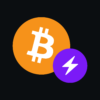A wrapped token is a type of cryptocurrency token that represents another cryptocurrency on a different blockchain. It’s called a “wrapped” token because the original asset is placed in a digital vault, or “wrapper,” allowing the wrapped version to be created on another blockchain
For example, Wrapped Bitcoin (WBTC) is a tokenized version of Bitcoin that exists on the Ethereum blockchain.
This allows Bitcoin to be used in Ethereum’s decentralized finance (DeFi) ecosystem token is pegged to the value of the original asset, and it can typically be redeemed (unwrapped) for the original asset at any time
Wrapped tokens increase interoperability between different blockchains, enabling assets to be used across various platforms and applications

What other wrapped tokens exist?
There are several wrapped tokens available, each representing different cryptocurrencies on various blockchains. Here are some notable examples:
Wrapped Bitcoin (WBTC) : Represents Bitcoin on the Ethereum blockchain
Wrapped Ethereum (WETH) : Represents Ethereum on the Ethereum blockchain, but in a format compatible with ERC-20 tokens
renBTC : Another version of wrapped Bitcoin, created by the Ren project
Wrapped Litecoin (WLTC) : Represents Litecoin on the Ethereum blockchain
Wrapped Zcash (WZEC) : Represents Zcash on the Ethereum blockchain
Wrapped Filecoin (WFIL) :Represents Filecoin on the Ethereum blockchain
What are the benefits of using wrapped tokens?
Wrapped tokens offer several benefits, particularly in the context of decentralized finance (DeFi) and blockchain interoperability:
Interoperability: Wrapped tokens allow assets from one blockchain to be used on another. For example, Bitcoin can be used on the Ethereum network through Wrapped Bitcoin (WBTC), enabling BTC holders to participate in Ethereum-based DeFi applications.
Liquidity: By wrapping tokens, liquidity can be brought from one blockchain to another. This helps increase the overall liquidity in DeFi platforms, making it easier for users to trade and invest.
Efficiency: Wrapped tokens can make transactions more efficient. For instance, using WBTC on Ethereum can be faster and cheaper than using Bitcoin on its native blockchain, especially during times of high network congestion.
Access to DeFi: Wrapped tokens enable holders of various cryptocurrencies to access DeFi services like lending, borrowing, and yield farming, which might not be available on their native blockchains.
Flexibility: They provide more flexibility in managing and utilizing assets. Users can leverage their holdings across different platforms and protocols without needing to sell or convert their original assets.
Security: Wrapped tokens are typically backed 1:1 by the original asset, ensuring that they maintain their value and can be redeemed at any time. This backing is often managed by custodians or smart contracts, adding a layer of security.
How do I wrap my tokens?
Wrapping tokens typically involves using a decentralized finance (DeFi) platform or a specific protocol designed for this purpose.
Here’s a general step-by-step guide on how to wrap your tokens:
Choose a Platform: Select a platform that supports the wrapping of the token you want to wrap. Popular platforms include Uniswap, SushiSwap, and platforms specific to certain tokens like WBTC.
Connect Your Wallet: Connect your cryptocurrency wallet (e.g., MetaMask, Trust Wallet) to the platform. Ensure your wallet has the token you want to wrap and enough ETH for transaction fees if you’re using the Ethereum network.
Select the Token to Wrap: On the platform, choose the token you want to wrap. For example, if you want to wrap Bitcoin, select WBTC
Initiate the Wrapping Process: Enter the amount of the token you want to wrap and follow the platform’s instructions. This usually involves approving the transaction and confirming it in your wallet.
Complete the Transaction: Once you confirm the transaction, the platform will lock your original tokens in a smart contract and issue the equivalent amount of wrapped tokens to your wallet.
Verify the Wrapped Tokens: Check your wallet to ensure the wrapped tokens have been received. They should appear as a new token in your wallet.
Example: Wrapping Bitcoin to WBTC
- Go to a platform like WBTC’s official site or a DeFi exchange like Uniswap.
- Connect your wallet.
- Select Bitcoin (BTC) as the token to wrap.
- Enter the amount of BTC you want to wrap.
- Approve and confirm the transaction.
- Receive WBTC in your wallet.
Can I unwrap my tokens later?
Yes, you can unwrap your tokens later. The process of unwrapping tokens is essentially the reverse of wrapping them. Here’s how you can do it:
Choose a Platform: Use the same platform or protocol where you initially wrapped your tokens. For example, if you wrapped Bitcoin into WBTC on Uniswap, you can use Uniswap to unwrap it.
Connect Your Wallet: Connect your cryptocurrency wallet to the platform. Ensure your wallet contains the wrapped tokens you want to unwrap.
Select the Wrapped Token: On the platform, choose the wrapped token you want to unwrap. For example, select WBTC if you want to convert it back to BTC.
Initiate the Unwrapping Process: Enter the amount of the wrapped token you want to unwrap and follow the platform’s instructions. This usually involves approving the transaction and confirming it in your wallet.
Complete the Transaction: Once you confirm the transaction, the platform will burn the wrapped tokens and release the equivalent amount of the original tokens back to your wallet.
Verify the Original Tokens: Check your wallet to ensure the original tokens have been received.
Example: Unwrapping WBTC to BTC
- Go to a platform like WBTC’s official site or a DeFi exchange like Uniswap.
- Connect your wallet.
- Select WBTC as the token to unwrap.
- Enter the amount of WBTC you want to unwrap.
- Approve and confirm the transaction.
- Receive BTC in your wallet.











Hi, this is a comment.
To get started with moderating, editing, and deleting comments, please visit the Comments screen in the dashboard.
Commenter avatars come from Gravatar.